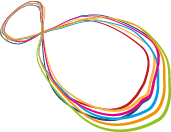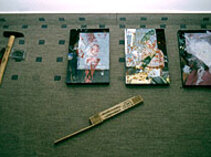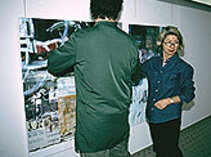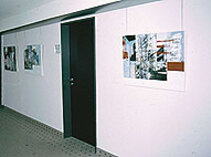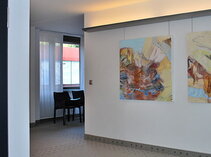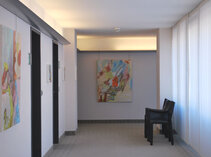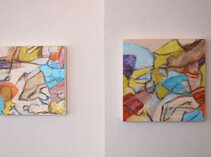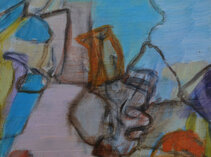Renate Thongbhoubesra
Exhibition opening on Sunday, April 28, 2002 at 12 noonA musical matinee with the Charles Gounod Wind Ensemble took place at 11 am.
Her latest works were presented from April 28 to June 23. In recent years, the artist has perfected the artistic combination of drawing, painting and photography using a sophisticated collage technique. For her, photographed reality is an aesthetic region whose painterly qualities are to be discovered and artistically developed.
This involves the inclusion or exclusion of sections and their combination with painterly means. She has been working on her "Thailand motifs" since 1968. Gradually, she sensitized her gaze to discover the special in the everyday. Using a camera, she searched for and found the painterly aspects and motifs of her subject matter.
Her most recent works revolve around the theme of "Insights-Outlooks". The painted surface gains depth as she arranges sublime overlays with paper foils and draws and paints them close to the photo and sometimes even over the photo. Bars, hatching and contours, which she creates with chalk and charcoal pencils, soften the overly strong expression of reality in the photo and gently embed it in the painterly structure of the picture. She works on the shadow line between abstract and concrete art. This is probably one of the most fascinating aspects of her art. Born in 1941, the artist has already had many exhibitions in Germany. She will soon be exhibiting in Salzburg, Metz and at the Villa Steinbach Musée des Beaux Arts in Mulhouse. She studied at the European Academy of Fine Arts in Trier under Harald Fuchs. She lives and works in Bad Krozingen and Bangkok.
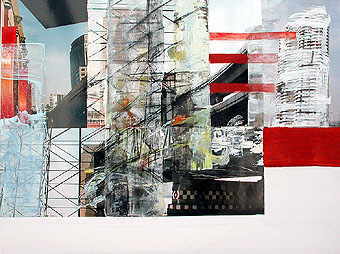
E-A4, MDF board and transparent film, pigments/chalk/acrylic, 60x80 cm
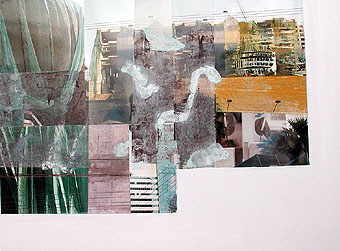
E-A5, MDF board and transparent film, pigments/chalk/acrylic, 60x80 cm
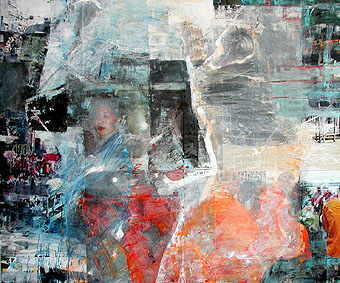
E-A6, MDF board and transparent film, pigments/chalk/acrylic, 60x80 cm
Exhibition preparation on the attic floor
Vernissage

After a successful opening: The artist congratulates the speaker Beate Hill-Kalusche.
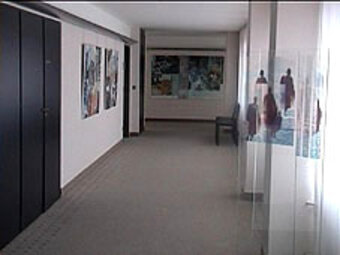
View of the triptych in the hallway of the attic floor.
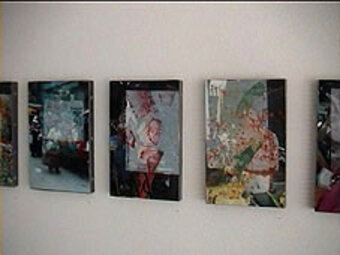
The parade of small-format works.
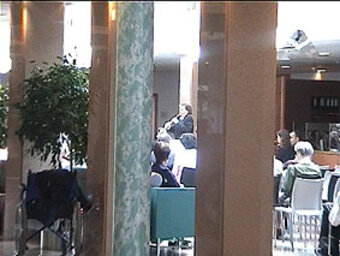
Musical matinee
Wolfgang Amadeus Mozart, Serenade in C minor, K. 388
The presentation of rarely performed masterpieces for large wind ensembles forms the basis for the special profile of the nine wind soloists from eight nations. The matinee program began with the Serenade in C minor, K. 388 by W.A. Mozart. Even in the first few minutes, the ensemble impressed with its vital and flawless intonation, its sensitive feel for delicate melodies and its balanced overall sound.
Carl Maria vonWeber, Concertino for oboe and winds
In Carl Maria von Weber's Concertino for oboe and winds, oboist Benedict Walter captivated the audience with his musical, highly dynamic interpretation. Completely different musical worlds unfolded in the last part of the program.
Charles Gounod, Petite Symphonie
In Charles Gounod's nonet "Petite Symphonie" in B flat major, the ensemble presented a late-romantic, almost lyrical work that gave the transverse flute room for melodious development. With brilliance and playful ease, the musicians emphasized the light transparency and gentle charm of the composition.
October 3 to November 26, 2010: Renate Thongbhoubesra >Strandungen<, Painting
The pictures created in 2010 focus on the search for traces on the seashore. Everything that the sea provides and randomly transports onto the sand of the coast comes together to form an order that is tracked down and artistically processed.
By exploring the corridors of the attic floor, visitors are transformed into beachcombers who repeatedly come across sections of strangely shaped and arranged objects that need to be identified.
For the most part, it remains with the form, which gains shape through the imagination and finally receives a designation or even a name.
The arrangement of the pictures contributes to the beach landscape. The back and forth in the rhythm of the architecture suggests the curved topography of the terrain. The composition of one picture dictates the motif of the other. A flowing ribbon of mosaic finds its way through the corridors of the Attica.
The artistic starting point is to be found in the dominance of the pictorial order. The motif of what is found unfolds in moving nature and in the process of artistic creation. Strandings are pictorial inventions of what nature provides and can be transformed into a picture.
Vita
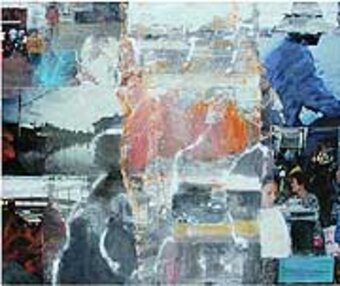
Pigments/photo/MDF, 2001
Beginnings
Surprising impressions shape our ability to perceive. Reality, especially when it is not compatible with everyday experience, opens the horizon of the eye and unfolds in a visual language that you have to learn to spell. Something like a visual code develops that provokes design. The artistic means are assigned to you, so that you begin to select sections of the point of view and transfer them to the aesthetic medium.
Perhaps such a scenario took place in 1968, when Renate Thongbhoubesra visited Thailand for the first time. At first, the country and its people were seen through the eyes of a tourist. The camera was a tried and tested means of documenting the trip. Then the hidden exoticism revealed itself - hidden in the everyday, which sometimes reveals itself to the European as a visual miracle. Gradually, she sensitized her gaze to discover what was special in her new surroundings. The medium changed along with the direction of her gaze. The camera advanced from a documentary instrument to a trace-reading device. For her, the photographed reality was an aesthetic region whose painterly qualities were to be discovered and artistically developed. The facades of reality became more transparent. The painterly aspects revealed themselves in hidden corners and remote regions. Artistic themes opened up. Motifs were added. Thus the subject emerged in a long process ...
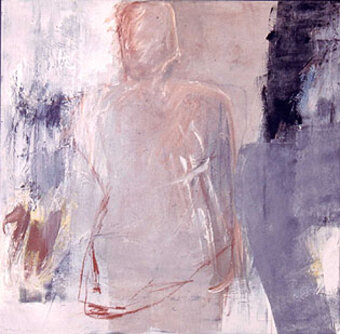
n.d., mixed media 90x90 cm, 1996
Education
Born in 1941, the artist began her artistic training in Staufen. There she took lessons in art history and painting with Barbara Köhler in 1982. The artistic and theoretical foundations aroused her curiosity. From 1993 to 1996, she spent the summer months at the European Academy of Fine Arts in Trier. Her teacher, the renowned artist Professor Harald Fuchs, was able to convey to her the decisive ideas of pictorial composition and experimentation with materials on the surface. She very quickly found her own way of combining photography, her invaluable medium for searching for reality, with painting using a sophisticated, experimental collage technique. With Harald Fuchs, she found what was important to her. Her own style crystallized and became more concise from work to work.

n.d., mixed media 30x50 cm, 1994
Pictorial order and composition
From the years after 1996, she initially created works in which she asserted the dominance of pictorial order. In her compositions, photography was given its own status, which was hardly affected by the elements of painting and drawing. In other words, the juxtaposition of painting and photography was structured into a homogeneous pictorial structure. It is noticeable, however, that even then the photographic motifs showed painterly aspects, which then came into contact with the painting. This paved the way for the process of artistic treatment of photography.
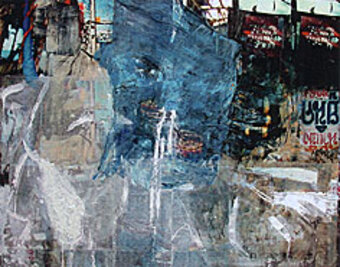
Pigments/photo/MDF, 2001
Renate Thongbhoubesra suggested the opening of the pictorial space on the surface. This was achieved on the one hand by the "Realisat Fotomotiv" and on the other by a process of sublime surface superimposition that initially seemed complicated. Let us follow these artistic steps in detail: The photos, or at least sections of them, are painted over in layers. The traces of paint conceal, cut out or allow shimmering through. This creates a wafer-thin spatiality and gives the photo a new aesthetic value. In the next step, these works are then covered with long-fiber paper, a kind of paper fleece. The depth effect increases. This artistic process took place over the years, from picture to picture, so to speak.
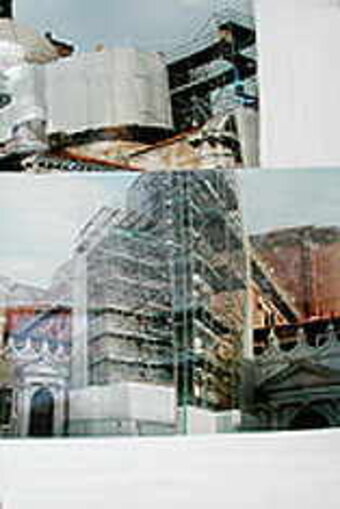
Facciata Pigments/Photo/MDF, 2001
A combination of artistic means of expression
The artist has created something fundamentally new. One can speak neither of a photo collage nor of a material collage, but rather of a combination of artistic means of expression. The painterly qualities of photography are combined with the artistic possibilities of the brush, chalk and charcoal. The long-fiber paper represents something like a mysterious ribbon that welds together the different aesthetic means of expression and presents them as a homogeneous image.
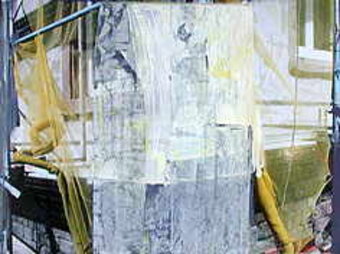
Facciata Pigments/Photo/MDF, 2001
A series of works, which the artist calls "Facciata" (facade), date from 2001. The photographic details show wall sections or lettering above windows and doors. Her free use of painterly means takes on traits of Tachism. As a result, these sections gain a reality of their own and enter into a dynamic field of tension with the photographic motif. The alternation between photographic and superimposed tachist sections contributes to the coloristic intensification. At first glance, the façades appear to be abstract surfaces in this constellation. But then the picture details turn into a representational pattern. The structures refer to the real components of a building wall. There is no doubt that the stupendous artistic expression lies in this balancing act between representational pattern and ornamental gesture.
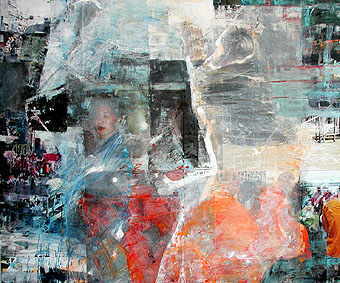
E-A 6, photo transparent film, pigments/chalk/acrylic, 60x80 cm, 2002
Insights - Outlooks
Her most recent works, created in 2002, revolve around the theme of "Insights-Outlooks". The painted surface gains depth as the artist arranges sublime overlays with paper foils and draws and paints them close to the photo and sometimes even over the photo. Beams, hatching and contours, which she creates with chalk and charcoal pencils, soften the overly strong expression of reality in the photo and gently embed it in the painterly structure of the picture. She works on the shadow line between abstract and concrete art. This is probably one of the most fascinating aspects of her art.
These works also include a triptych, which expresses the artist's tendency to unite disparate pictorial motifs. She had already created triptychs and diptychs in earlier years. The creation of pictorial units via interstices and interruptions becomes an aesthetic calculation for her, as these two- and three-part types of picture give her greater freedom in searching for and finding pictorial motifs and expand the scope of collage. Viewers will be surprised to discover that the clearly separate and divided motif components can be seen together.
Renate Thongbhoubesra lives and works in Bad Krozingen and Bangkok.
Exhibitions
- 1993 Bad Krozingen, Heart Center
- 1995 Bangkok/Thailand, Goethe Institute
- 1996 Freiburg, Städtische Galerie Schwarzes Kloster
- 2001 Wolfsburg, Theater-Galerie n 2001 Baden-Baden, Staatliche Kunsthalle
- 2001 Siegen, Gallery in the Picture Factory
- 2002 Bad Krozingen, Heart Center
- 2002 Metz, Parc des Expositions
- 2002 Mulhouse, Villa Steinbach/Musée des Beaux Art

